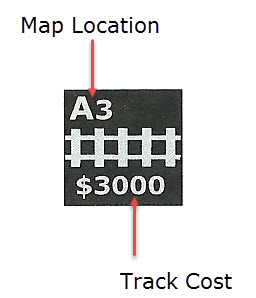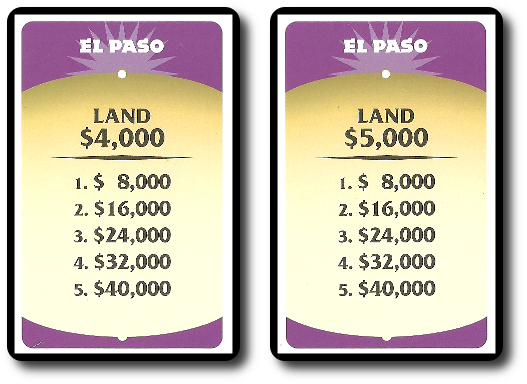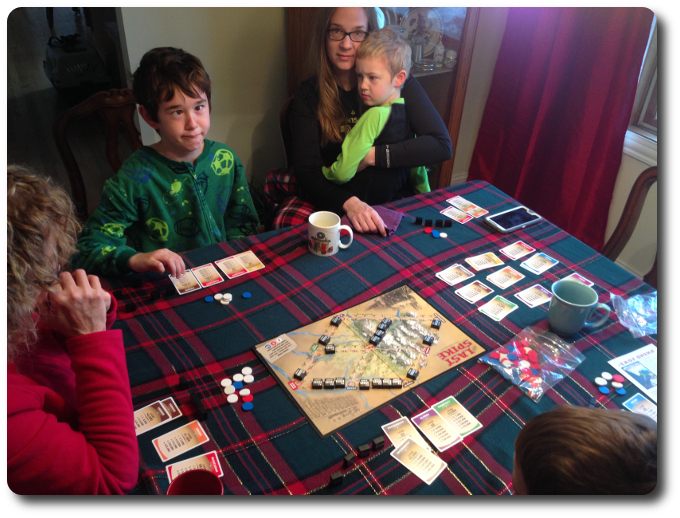
The Basics:
- For ages 8 and up (publisher suggests 10+)
- For 2 to 6 players
- Approximately 45 minutes to complete
Geek Skills:
- Counting & Math
- Logical & Critical Decision Making
- Reading
- Pattern/Color Matching
- Strategy & Tactics
- Risk vs. Reward
- Hand/Resource Management
Learning Curve:
- Child – Easy
- Adult – Easy
Theme & Narrative:
- Speculate and engineer your way to victory
Endorsements:
- Gamer Geek mixed!
- Parent Geek approved!
- Child Geek approved!
Overview
When the United States looked westward to the new territories it acquired, many saw a chance for a new life. Even more saw opportunities for wealth. Acquiring ownership of this new land meant speculating its worth. For those who could manipulate the railroad, land became better than gold.
The Last Spike, designed by Tom Dalgliesh and published by Colombia Games, is comprised of 1 game board, 48 Railway Track tiles, 45 Land cards (5 cards for all 9 cities), and a large number of Currency chips (in the colors white, red, and blue representing $1000, $5000, and $10,000). The game board is thick enough to be durable, but is not as thick as most game boards. There is a rather large crease down the middle where the game board folds in two, but the crease does not stop the game board from sitting flat or cause problems during game play. The Railway Track tiles are made of solid wood and the cards are as thick and as durable as your standard playing card. The Currency chips are small and made out of wood, as well.
Note: This review details the 2015 version of the game.
Game Set Up
To set up the game, first place the game board in the middle of the playing area.
Second, assign 1 player to be the Banker and give them the Currency chips to organize and control. The Banker will now organize the Currency chips by color and give each player their starting sum of money. The amount of money given is based on the number of players. For example, in a 2-player game each player is given $60,000 worth of Currency chips, but in a 6-player game, each player is given $30,000 worth in Currency chips. The Currency chips prepared by the Banker are given directly to the player.
Third, while the Banker is busy organizing the cash, another player can be organizing the Land cards by City name and then by Land Price. The Land Price value of “0” should be on top and the next highest price below and so on, creating 9 piles of Land cards. All values should be face-up and easy to read. Organize these cards off to one side of the game playing area.
Fourth, place the Railway Track tiles face-down (or in a bag) and randomize them. This is the Railway Track tile pool for the duration of the game. Determine which player will go first in the turn order. Then, in turn order sequence, have each player draw 4 Railway Track tiles each. These drawn tiles are placed in front of the player so only the owning player can see the values on the tiles before they are played.
A Land of Opportunity
The Last Spike is played in turns with no set number of turns per game. A typical player turn is summarized here.
Step 1: Lay Track
Each Railway Track tile has as alphanumeric value (a letter and a number). The letters represent which route the tile belongs to and the number indicates where on the track it’s placed. There are 12 routs in total and each route is comprised of 4 Railway Track tiles for a total of 48 Railway tiles to be collected and placed. It it highly unlikely that all of them will be used, however.
To place a Railway Track tile, a player must be able to pay for its track cost. The cost of laying the specific strip of track is indicated on the Railway Track tile. Additionally, the Railway Track tile must be placed on specific map location found on the game board. The map location is noted on the tile, as well. A player cannot place a Railway Track tile noted as “A2” on the “D4” map location. In this way, each Railway Track tile has a reserved spot on the game board.

Placing the Railway Track tile next to a City (tiles with number “1” and “4”) or adjacent to a Railway Track tile will only cost the player the noted amount on the Railway Track tile being added. If the player places a Railway Track tile that is not adjacent to a City or to another Railway Track tile, they must pay double the listed price. Thematically speaking, the extra cost covers the work to move the necessary building materials across difficult and remote terrain.

The cost of the Railway Track tiles varies based on where they are located on the map. Geographic areas that are flat and more or less clear of trees are cheaper to build upon than in the mountains, for example.
Short on Cash and Bankruptcy
If the player cannot pay for any of their Railway Track tiles, they must sell any Land cards they have previously acquired. Land cards are always sold back to the Banker and never to an opponent. It should also be noted that a player is not allowed to borrow money from the Banker or from an opponent. Sold Land cards are placed back on the table to be purchased and the player receives half of its value (rounded-up) from the Banker. The Banker cannot accept “Free” Land cards or any Land cards that have Paid Out. The player must continue to sell their Land cards until they can pay to place a Railway Track tile.
In the rare case that a player is still unable to raise enough capital by selling Land cards, they must claim bankruptcy and are out of the game. All unplayed Railway Track tiles are returned to the Railway Track tile pool, any Currency chips are returned to the Banker, and all but the “Free” Land cards are returned to play.
Making Money
If a player places a Railway Track tile that connects 2 Cities, a Pay Out is triggered. Every player who owns a Land card that belongs to either of the Cities now stands to make some money. The amount earned is based on the number of Land cards the player has. The Banker distributes the Currency chips as required. A player need not own land in both Cities to benefit.

Step 2: Buy 1 Land Card (Optional)
Land cards can only be purchased for those Cities that have 1 or more Railway Track tiles connected to them. Any player who is the first to place a Railway Track tile to a City receives the “Free” Land card. This cannot be sold back to the Banker, but it does count as 1 portion of land owned that can now be used for a Pay Out.

After the “Free” Land has been claimed, any player can purchase Land cards for that city regardless of where they placed their last Railway Track tile. Only 1 Land card can be purchased per player per turn. The player who receives the “Free” Land card cannot also buy a Land card on their same turn. Players will painfully note that the price of land increases each time a Land card from a specific City is purchased. Thematically speaking, the land owners have noticed that they have a hot commodity and are eager to make a profit. The lesson here is to buy land early.

A player need only be able to afford the available Land card to claim it. They pay the Banker and place the acquired Land card in front of them, face-up. Note that the cost of the Land card does not influence the Pay Out. The price of the Land card only determine how much money the player must pay to acquire it.
Step 3: Draw 1 Railway Track Tile
A player’s final action on their turn is to draw 1 Railway Track tile at random from the Railway Track tile pool. This new tile is added to the others and can be played as soon as the player’s next turn.
The Last Spike and Winning the Game
The game ends when the “Last Spike” is played. The Last Spike is the name given to the Railway Track tile that completes a continuous route from St. Louis to Sacramento (through any number of other Cities). The player to place the Last Spike is awarded an additional $20,000 from the Banker.
A final Pay Out is now completed (as placing the Last Spike connected 2 Cities) and then all the players count their Currency chips to determine the total amount of money they have. The price of the Land cards is not counted during this time.
The player with the most money wins the game. If there is a tie, the player with the highest total cost off all collected Land cards wins.
Game Variant
In a 2-player game, draw 1 Railway Track tile during game set up and remove it from the game. Do not let any player see the Railway tile’s value.
To learn more about The Last Spike, visit the game’s web page.
Final Word
The Child Geeks who were already familiar with Train games quickly understood the rules. It took only slightly longer for those Child Geeks not familiar with such games to grasp the most basic and advanced concepts of game play. According to one of these Child Geeks, “I didn’t understand how to make money at first, but it’s actually really easy if you are lucky.” Luck, however, only has one part to play. All the Child Geeks observed that they had more control over the expansion of the railroads than they initially presumed. As one Child Geek put it, “If you wanted to, you could build railroads between cities quickly. I think it’s better not to, however.” Whether to build quickly or slowly was debated by the Child Geeks. What was not in dispute was the game’s full approval.

Not my best group photo, but this was the best out of 10 (Child Geeks don’t always cooperate)
The Parent Geeks were most pleased with the game. Train games continue to be enjoyed by both the non-gamer and casual player Parent Geek crowd, as well as the more experienced Parent Geeks. One Parent Geek was already familiar with the game, having played the original version. According to this Parent Geek, “This game has been greatly improved. It’s much tighter, faster, and has a lot less luck in it.” A non-gamer Parent Geek said, “I was a bit confused about why I would want to buy Land cards in other locations, but all it took was one pay out and I understand everything now.” The Parent Geeks, like the Child Geeks, enjoyed themselves and were ready to play another game when the previous one ended. Before doing so, they voted to fully approve The Last Spike.
The more casual Gamer Geeks enjoyed the game, finding it to be a good mix of critical thinking and tactical playing. They all thought that there was a small element of luck, but with more than 1 Railway Track tile to select from on their turn, they never felt like anything in the game was randomly determining game play. According to one of these Gamer Geeks, “This is a solid game. It plays casually, but you really have to watch what you and the other players are doing. It’s very tight, has good balance, and moves surprisingly fast.” The more elite Gamer Geeks found The Last Spike to be flawed. According to one of these Gamer Geeks, “The limits where you can play your tiles and the random pay outs make the practice of tactically purchasing land for points and earning points painful.” It was this randomness that left the elitists cold, as they were never fully satisfied with what they had and were most certainly upset by not being able to do what they wanted in the game. In the end, the Gamer Geeks gave The Last Spike a mixed level of approval.
I often describe The Last Spike to new players as “Monopoly meets Ticket to Ride“. This is not, of course, completely true, but it does quickly capture the two most important aspects of the game. The first is the acquisition of property based on speculation. This is exactly what Monopoly is. Players traverse the game board buying property with the assumption that their opponents will land on it and provide a steady source of income. Speculate incorrectly and the player ends up spending money on property that provides very little return. The Ticket to Ride aspect is fairly obvious with the laying of track and connecting certain destinations. It’s the merger of these two aspects that make The Last Spike interesting. Players spend points to acquire Land cards that might provide points. All the while, they must also pay to lay the track, making the game a difficult exercise in managing finances and guiding the game so as to turn a profit.
Sounds difficult, but it isn’t. The game play is very smooth, with nothing in the way of random outcomes that upsets tactical decisions. Which is not to say that a player won’t be tasked to make tough choices. The Railway Track tiles they have can always be placed, but a player must balance the cost of the tile with the benefit it provides. At the same time they must consider what land they have and the best way to earn a profit.
This game also uses a game mechanic that I have always enjoyed: the spending of points to earn points. I find this to be an interesting exercise as the resource I’m spending and losing is also the resource I want to earn and keep. It makes the choices more “real”, so to speak, as I know that what I’m giving up needs to return to me. This makes choices feel more visceral to some degree. Intellectually, I know what I’m doing is sound due to the math adding up. In my gut, I’m not liking the fact that I’m giving up that which I need to win. It’s truly a tug-o-war between risk and reward.
I’m most pleased with The Last Spike. It presents its players with a simple challenge: make money. But to do so, players must spend it, take calculated risks, and subtly attempt to manipulate others into helping them reach their goals. For a game that plays quickly and looks so simple, there’s a lot going on beneath the surface. Best of all, it’s a game that everyone can play and the more players you have at the table, the more heated the game becomes. Do sit down and play The Last Spike before this train leaves the station.
This game was given to Father Geek as a review copy. Father Geek was not paid, bribed, wined, dined, or threatened in vain hopes of influencing this review. Such is the statuesque and legendary integrity of Father Geek.



